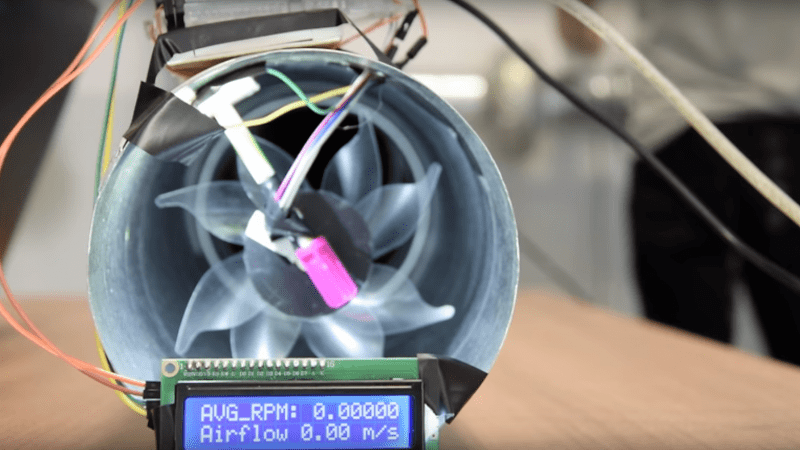Everyone is familiar with pinwheels, and few of us haven’t crafted one from a square of paper, a stick, and a pin. Pinwheels are pretty optimized from a design standpoint, and are so cheap and easy to build that putting a pinwheel to work as an HVAC duct flow meter seems like a great idea.
Great in theory, perhaps, but as [ItMightBeWorse] found out, a homemade pinwheel is far from an ideal anemometer. His experiments in air duct flow measurements, which previously delved into ultrasonic flow measurement, led him to try mechanical means. That calls for some kind of turbine producing a signal proportional to air flow, but a first attempt at using a computer fan with brushless DC motor failed when a gentle airflow couldn’t overcome the drag introduced by the rotor magnets. But a simple pinwheel, custom cut from patterns scaled down from a toy, proved to be just the thing. A reflective optosensor counts revolutions as the turbine spins in an HVAC duct, and with a little calibration the rig produces good results. The limitations are obvious: duct turbulence, flimsy construction, and poor bearings. But for a quick and dirty measurement, it’s not bad.
Looking for an outdoor anemometer rather than an HVAC flow meter? We’ve got one made from an old electric motor, or a crazy-accurate ultrasonic unit.
















“The limitations are obvious: duct turbulence, flimsy construction, and poor bearings.”
You forgot, “kids running off with it”
B^)
Smiling all the way,
you just made my day.
When I needed to balance a bunch of HVAC ducts, I used 1″ foam board & duct tape to make a funnel and put a large muffin fan at the small end. I used a DVM to read the output voltage from the fan. I didn’t bother to calibrate it because I just needed relative measurements. Worked just fine. If I’d had someone to drive the car while I took data, calibration would have been simple enough. Eventually the duct tape dried up and I used the foam board for other things.
Take cooling fan apart and pull out the magnet ring. Most are plastic not ceramic. Good bearings, real fan, and no cogging. Leave a little of the magnet on and sample one of the coils directly for speed pips, or go optical.
I would try to remove the coil and use the hall-sensor.
Everybody jumps on ultrasonics to measure airflow but frequencies in the upper audio range work just fine for a quickie handheld home quality device. Even a children’s pinwheel and counting the turns over 15 seconds is adequate enough. Large buildings with automation one of the earlier airflow sensors was essentially a potentiometer with weathervane that would hang vertical at no airflow and rotate towards horizontal as the airflow increased. Nowadays baro sensors with an orifice placed perpendicular in the airflow are used to sense the small pressure drop of moving air and these sense well enough to also determine what doors and windows are open or closed within hallways or rooms throughout the building.
For temporary home use? I’d use a feather and measure the angle it rotates in the airflow. Pinwheels spin too fast for old eyes to count, or would put me to sleep.
Why not install a “small” tube with a thermistor at both ends. Between the thermistors, install a low-wattage heater, to which you apply a known voltage/current. Knowing the amount of power being applied to the heater and measuring the delta T between the thermistors, you can calculate the velocity. This is a common HVAC trick used by contractors who are checking airflows on systems with electric heaters installed.
This method would have limitations. It doesn’t account for the average velocity across the duct (turbulence), but you could select a point sufficiently far away from sources of turbulence to get a pretty good measurement. It also does not account for the velocity profile across the duct. You’d have to select a point that best measures the average velocity.
Maybe I’ll try this one myself. Maybe I could sell this to HVAC contractors!
Best hack I heard about measuring HVAC airflows is the “garbage bag method”: time how long it takes to inflate a known-volume bag with the exiting airflow.
Wonder if one couldn’t hack an automotive heated wire mass airflow sensor to do this job. I should look into this.
This brings to mind the same question I have every time I see a home-made anemometer. How do you calibrate it? It makes perfect sense that the RPMs of the shaft would be proportional to the airflow but what is the proportion? Is it a simple calculation from the radius of the wheel? If so then what about different vane designs? Different number of vanes? Friction in the shaft?
I would love to know the answers because then I could make one to measure wind speed.
The video says anemometer (correctly) but the top image display says airflow then says m/s which is a unit of velocity not airflow unless the duct area happens to be exactly 1 meter squared at which point airflow m^3/s would equal air velocity m/s. The article also says flow meter in the title which is not what is displayed granted the difference is just a calculation and a measurement. Actual HVAC systems use something as simple as two tubes with holes in them and a differential pressure sensor. Advantage being minimal increase in static pressure and few or no moving parts. The ultrasonic system has the advantage that it should be able to measure the duct size (if round) and calculate airflow although the value displayed in the video is velocity.
Thanks